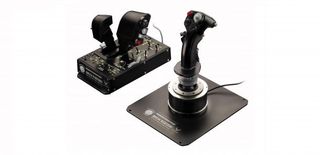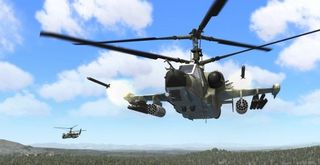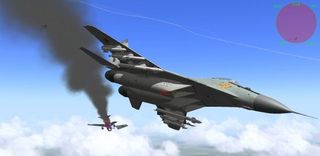In Simulation: Thrustmaster HOTAS Warthog flightstick and throttle

Andy Mahood takes to the skies, race tracks, and battlefields in our monthly In Simulation column to showcase the best that sim games have to offer. This month, Andy test drives the Ferrari of flightsticks and shows how it can take your flight sim experience to the next level.
"Always use the right tool for the job.” Sage advice from my father many years ago, but his words rang especially true this past month when I finally got my paws on Thrustmaster's latest HOTAS Warthog A-10C flightstick and throttle.Weighing in at almost 15 pounds, the mostly metal HOTAS Warthog is the Rolls Royce of Hands-On-Throttle-And-Stick controllers for current-generation flight sims. It ain't cheap (the best online price I could find was $350), but if you're serious about your virtual combat flying, it's one of the best investments you can make.

The natural successor to Thrustmaster's decade-old all-steel F-16 replica HOTAS Cougar, the HOTAS Warthog improves on its forebearer by using 3D magnetic sensors rather than potentiometers (which notoriously wore out under heavy use with the Cougar). The flightstick—which feels so solid and responsive you'll never want to go back to plastic—features an eight-way point-of-view hat, three four-way hats, a dual-stage trigger, and four push buttons including a removable paddle switch (for A-10C realism zealots who don't want this F-16 feature on their Hogs).
The throttle body is similarly impressive. Crafted from mostly steel components, the weighted base incorporates an impressive array of LED-illuminated buttons and military-quality switches that emulate
the exact throw and resistance of the real thing (Thrustmaster purportedly even measured the “volume” of each switch click for additional authenticity). Friction resistance on the split throttle is easily adjustable and, in keeping with the “hands-on” principle of the original USAF design, incorporates a mouse hat with push button, an eight-way POV hat, a four-way hat, and assorted three-position switches. You can lock the throttles together for synchronized operation, and there are also lift and push/pull detents for the idle and afterburner ranges.
The greatest of ease

For all of its apparent complexity, the HOTAS Warthog is plug-and-play from the get-go. There's no disc to install, and you can be up and running in minutes once you connect it to the USB ports on your PC. Picking the first test sim was a no-brainer: I fired up Eagle Dynamics' DCS: A-10C Warthog for its maiden flight with the new controller. I was thrilled to discover that the simulation auto-detected the device and delivered a preset configuration of button presses and axis assignments that worked perfectly without any tailoring or adjustments on my part.
The Warthog doesn't ship with rudder pedals, so I had to draft a set of CH Products Pro-Pedals into service, but once I had my plane airborne, I was flying more efficiently than ever before. With its 16-bit axis resolution, the controller delivered surgical stick and throttle response and it was a treat having most of my significant commands—weapons, flaps, speed brakes, targeting slew control—within fingertip range. You'll feel like a USAF pilot after an hour with this product.
PC Gamer Newsletter
Sign up to get the best content of the week, and great gaming deals, as picked by the editors.

Making the HOTAS work with other modern flight sims (such as Flaming Cliffs 2, Black Shark, Rise of Flight, and IL-2 Sturmovik: Cliffs of Dover) took a little more effort, as they typically only detect the control axes and a few buttons. However, you can download a software client from Thrustmaster called TARGET that offers additional presets and virtually limitless configurability. Once I'd gotten all the various specifications set up to my liking, I developed an entirely new appreciation for these sims, especially the non-historical ones where button-festooned HOTAS cockpits are the order of the day.
I still struggle occasionally with the nuances of rotary-wing flight in DCS: Black Shark, but I'm enjoying the hell out of DCS: A-10C and Flaming Cliffs 2 right now and anticipate exhaustively honing my skills in the weeks and months ahead.
Having the right tool for the job really makes a helluva difference.
What do you think? Send Andy your thoughts and questions at insimulation@pcgamer.com

Morels: The Hunt 2, an intensely chill game about gathering mushrooms and taking pictures of animals, is my unexpected new obsession

Dwarf Fortress's graphical adventure mode launches today, includes extremely Dwarf Fortress touches like '186 animal people portraits' and a unique sound effect for walking on soap
Most Popular



